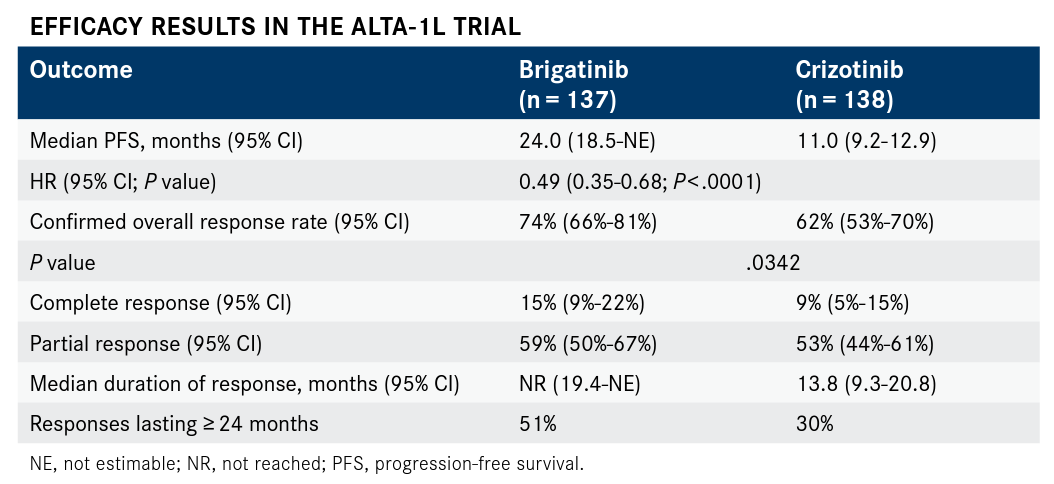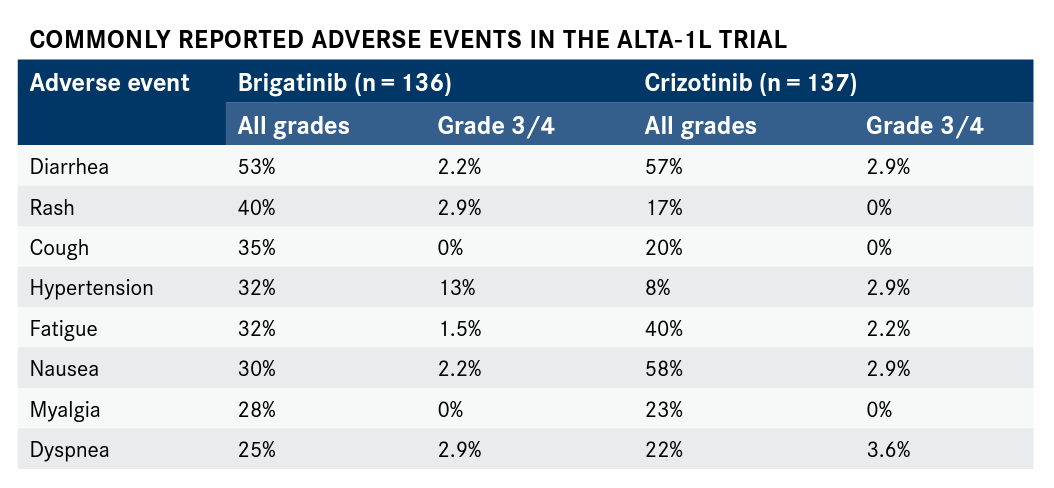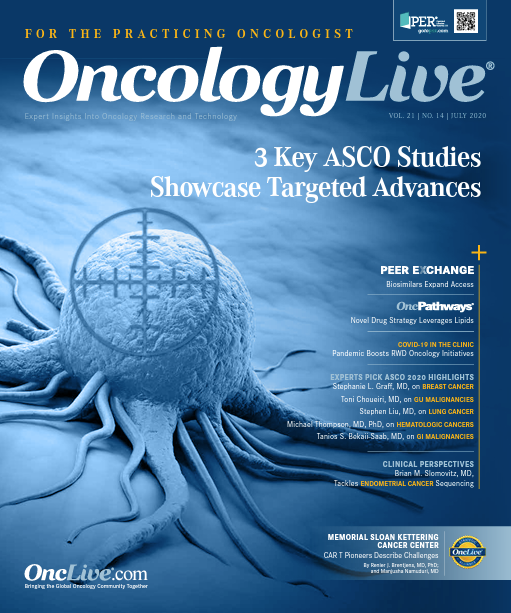Publication
Article
Oncology Live®
New Indication Propels Brigatinib Into the Front Line for ALK-Positive NSCLC
Author(s):
Thomas E. Stinchcombe, MD, discusses brigatinib’s mechanism as well as the next steps to advance the treatment paradigm for patients with ALK-positive NSCLC.
Thomas E. Stinchcombe, MD

The tyrosine kinase inhibitor brigatinib (Alunbrig) holds the promise of superior outcomes compared with standard-of-care option crizotinib (Xalkori) in patients with ALK-mutant non–small cell lung cancer (NSCLC). On May 22, 2020, the FDA approved brigatinib for the frontline treatment of patients with ALK-positive metastatic NSCLC, as detected by an FDA-approved test. Brigatinib was initially approved in 2017 for patients with ALK-positive disease who either experienced disease progression on crizotinib or were unable to tolerate the agent.1,2
Brigatinib’s latest approval is based on progression-free survival data from the phase 3 ALTA-1L trial (NCT02737501) that demonstrated frontline treatment with brigatinib led to a median progression-free survival of 24 months (95% CI, 18.5-not estimable) versus 11 months (95% CI, 9.2-12.9) with crizotinib (HR, 0.49; 95% CI, 0.35-0.68; P < .0001). The confirmed overall response rates were 74% (95% CI, 66-81) and 62% (95% CI, 53-70), respectively.1
A subset of the clinical samples collected from ALTA-1L were retrospectively tested with the Vysis ALK Break Apart FISH Probe Kit, which was approved in tandem with brigatinib as a companion diagnostic to help select patients eligible to receive the drug. Of the 270 patients enrolled, 239 had positive results.
In an interview with OncologyLive®, Thomas E. Stinchcombe, MD, an expert in lung cancer at the Duke Cancer Institute and professor of medicine at Duke University School of Medicine, both in Durham, North Carolina, discussed brigatinib’s mechanism as well as the next steps to advance the treatment paradigm for patients with ALK-positive NSCLC.
OncologyLive®: What was noteworthy about the efficacy data that led to the approval?
Stinchcombe: The progression-free survival was significantly longer with brigatinib compared with the standard therapy, crizotinib. The difference was particularly striking when we looked at the patients with brain metastasis at baseline. Brigatinib continued to be of benefit in patients without brain metastasis as the ALTA-1L trial progressed.
What toxicities do clinicians need to be aware of?
I would break down the toxicities to 3 broad categories. One is laboratory-associated adverse events such as increased amylase lipase, increased creatinine, and increased creatine phosphokinase. These need to be monitored without regular laboratory evaluation. Investigators also noted an increase in hypertension; about 10% of patients had grade 3 hypertension.
The toxicity that I think is unique to this drug and probably requires the closest observation is the rate of interstitial lung disease/pneumonitis. In the brigatinib arm, about 5% of patients had interstitial lung disease/pneumonitis versus 2% in the crizotinib arm. This drug has a unique sort of early-onset pulmonary events, defined in this trial as events that occur within the first 14 days. These were observed in about 3% of patients in the brigatinib arm and none in the crizotinib arm.
Mechanistically, what causes brigatinib to be more efficacious than crizotinib in patients with brain metastases?
With crizotinib, we found that some patients with this disease would develop ALK tyrosine kinase resistance mutations, which was a common mechanism for resistance. Additionally, we saw that crizotinib penetrated the blood-brain barrier poorly, so a brain metastasis or central nervous system disease often was a site of disease progression.
Brigatinib targets a broad range of those ALK resistance mutations and has better central nervous system penetration than crizotinib; thus, it delays the development of resistance and has better central nervous system activity.
How does this agent advance the NSCLC paradigm, and what are the next steps?
Among patients with adenocarcinoma, depending on the case series of patients, anywhere from 5% to 10% will have an ALK rearrangement.
This is a very exciting space. We had the initial approval [of] crizotinib, and then more recently, alectinib [Alecensa] has been approved in the frontline setting. The next-generation ALK inhibitors have improved the outcomes of patients by prolonging progression-free survival by several years. We’re looking to make further improvements and have additional treatment options for this patient population.
The inevitable comparison to brigatinib is going to be the current standard, alectinib. If you do the cross-trial comparisons, the efficacy looks relatively similar, so I think most physicians are going to talk to their patients about alectinib and brigatinib and the relative benefits and the toxicity associated with each of them.
Regarding next steps, we have moved our next-generation agents into the front-line setting, but we need to develop drugs that are active after first-line treatment with next-generation ALK tyrosine kinase inhibitors. The field also needs a better way of defining who benefits from specific ALK inhibitors, potentially by using ALK mutation status, so we can continue to make progress in this disease. Current trials will investigate the optimal sequence of ALK tyrosine kinase inhibitors.
Efficacy Results in the ALTA-1L Trial

Commonly Reported Adverse Events in the ALTA-1L Trial

References
- Alunbrig. Prescribing information. Ariad Pharmaceuticals, Inc; 2020. Accessed June 29, 2020. https://www.accessdata.fda.gov/drugsatfda_docs/la-bel/2020/208772s008lbl.pdf
- Hematology/oncology (cancer) approvals & safety notifications. FDA. Updated June 24, 2020. Accessed June 29, 2020. https://www.fda.gov/drugs/resources- information-approved-drugs/hematologyoncology-cancer-approvals- safety-notifications









